THE HOME OF TIMELESS ART: THE METROPOLITAN MUSEUM OF ART (THE MET)
Overview of The Metropolitan Museum of Art
Recently, I had the pleasure of sitting down for an enjoyable interview with Gila Benmayor at Yıldız Holding’s Çamlıca Campus (https://www.ekonomim.com/kose-yazisi/murat-ulker-koleksiyoner-degilim-sadece-ev-sahipligi-yapiyorum/745041). In our conversation, we touched upon a range of topics, including how art serves as a healing force for society and its role in fostering both personal and corporate growth. I brought up my recent GOYA at the Metropolitan Museum of Art (The Met) and mentioned that The Met team would soon be visiting our holding company. This prompted me to realize that I hadn’t yet documented my experience with the GOYA at the museum. I felt it was time to share my experiences and the knowledge I gained there.
The Metropolitan Museum of Art, or “The Met” as it’s widely known, stands as one of the world’s premier museums in Manhattan right by Central Park. It boasts a vast collection that spans from Ancient Near Eastern artifacts to Egyptian, Greek, and Roman treasures. Part of its European Medieval collection is housed in a separate building within Manhattan, so if you ever get the chance to make a GOYA to the Met, make sure not to miss this annex as well. The Met also includes a research library, a dedicated children’s section, and dynamic educational exhibits. As you would appreciate, with its extensive collection of over two million works, seeing everything in a single day is impractical. However, with a well-planned visit, you can explore most of the highlights. Notably, The Met also served as a key location for the 1990 film “All the Vermeers in New York” (*), a visually rich choice thanks to its architecture and setting.
When making GOYAs at museums, my initial approach is always to dig into their history. In a place like The Met, with its vast collection spanning multiple eras, I’m curious—when did it bring all these works together, and why? After all, a museum visit is like traveling through time. So, let’s take a moment to explore this historical journey ourselves.
The origins of The Met date back to 1866, when a group of Americans decided to establish a “national institution and art gallery” to provide art and art education to the public. At the time, Americans saw art as a vital part of their national heritage and were dedicated to sharing it with the public. John Jay, a lawyer, swiftly took the lead on this initiative, laying the groundwork for what would become The Met.
Under Jay’s leadership, individuals from diverse backgrounds united, and on April 13, 1870, The Metropolitan Museum of Art was officially founded. Initially located in the Dodworth Building at 681 Fifth Avenue, the museum quickly attracted attention, with its first notable acquisition—a Roman sarcophagus—drawing the interest of art enthusiasts and collectors. By 1880, just a decade later, the museum relocated to its current site at Fifth Avenue and 82nd Street, moving into an architecturally striking building designed by Calvert Vaux and Jacob Wrey Mould. Through multiple expansions over the years, the museum has evolved into the impressive institution we know today.
Over the years, the museum has made significant efforts to continually expand and diversify its collection. Imagine the monumental effort required to gather over two million works spanning from ancient times to the modern era. One thing that caught my attention during the GOYA was the presence of artifacts from so many different regions. Here’s why: America, often referred to as the “New World,” lacks any ancient cultural remnants on its soil. The Met’s founding philosophy revolves around this-educating the American public by introducing them to the richness of various cultures. To highlight civilizations like the Romans and Ancient Egyptians, the museum has transported entire cultural artifacts, including temples and palaces, from their original locations into the museum. Some of these pieces, such as complete buildings and rooms, have been relocated intact from their home countries. We are not just talking about a fragment of an ancient Egyptian temple, an Italian manor, or even a historical fountain or its motifs—The Met has dismantled and relocated entire rooms, like the Fountain Room. It might seem unconventional, but I found the museum highly successful in conveying entire cultures. When I think about it, no one here would consider opening an extra museum to learn about the Romans or Egyptians, let alone transporting massive temple structures. But then again, everyone here already knows about the Romans and Egyptians, right?

The Islamic art section at The Met was added later on. Until 1932, Islamic art was part of the Near Eastern Art section. However, as the significance of Islamic art grew and the museum sought to introduce it to wider audiences, a dedicated Islamic Art department was established in 1963. The richness and diverse historical periods covered by Islamic art led to the creation of this section. Visiting the Islamic Art department was particularly exciting for me. It clearly showcases the changes and interactions within Islamic art across different regions and periods. In this regard, I would say the museum achieved its goal. The comprehensive Islamic art collection at The Met spans a vast geographical area, from western regions like Spain and Morocco to Central Asia and Indonesia. The collection includes both sacred and secular objects, with key elements such as calligraphy, botanical motifs, and geometric patterns—essential components of Islamic art. The collection is displayed with a sense of historical and geographical flow; for instance, you can see pieces from India, Iran, Türkiye, and Andalusia. As you may know, one of the most important artistic developments in the Islamic world is the evolution of calligraphy, expressed in various styles around the sacred concept of the Qur’an and its holy words (verses). Over there, you can find the Blue Qur’an from the 9th or 10th century. It’s an incredibly early piece and a true masterpiece. I remember about ten years ago, we hosted an exhibition titled “1400 Years of the Qur’an,” supported by the Republic of Türkiye, with a book also published to complement the event. There were some incredibly rare examples in that exhibition.
Throughout the different phases of Islamic art, whether in Andalusia or Ottoman palace periods, you will encounter artifacts sourced from across the globe. For example, the largest collection of Chinese porcelain in the world is housed in Topkapı Palace. Across the globe, as diverse cultures embraced Islam, they infused Islamic art with their unique cultural elements, creating a rich blend of influences. Take the Seljuks, for instance, with their figurative representations, or the crowns of Iranian Shahs, influenced by Sasanian and Greek designs. Hajj hats from Indonesia and South Sulawesi Island, and the geographic journey of gold leaf and various colored paints through history—these are all aspects you can experience and explore as you delve into the museum.
By the way, I should mention that for those passionate about Islamic art, you can check out our “Talking Writings” exhibition from the Yıldız Holding Islamic Art Collection, along with exhibitions like “Famous Calligraphers in the Flow of History”, which we have displayed in several cities across Türkiye. It’s a great chance to hear what these works have to share with you.
Let’s get back to the main point. The Met has unveiled its newly renovated galleries, featuring works from Türkiye, Arab countries, Iran, and Central Asia. These galleries showcase Islamic art from various periods and regions, including architectural pieces, manuscripts, ceramics, textiles, and decorative objects. The museum organizes these works according to the nations and states that shaped Islamic history, providing a clear view of how Islamic art evolved and interacted with different cultures over time. For example, while figural representations vanished in the Hejaz region after the Prophet’s time, it’s fascinating to see how they were used in Anatolian art by Muslim Turks. Doesn’t this highlight how thought, life, and art evolved uniquely in different parts of the Islamic world?
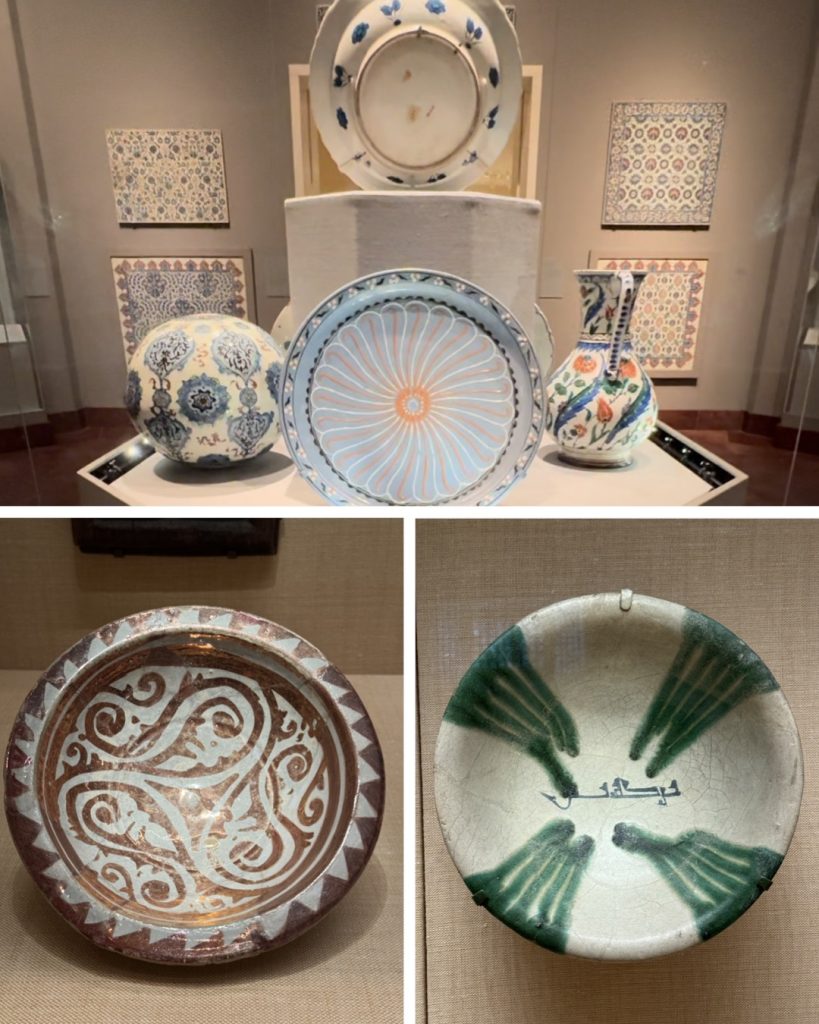
At this very point, I would like to mention an interesting historical interaction: following the Mongol invasions, the Mongols converted to Islam and integrated into society, bringing their cultural influences into Islamic art. As they embraced Islam, the Mongols infused their art with elements from the cultures that had previously shaped them. Consequently, we can observe the influence of Chinese civilization within the Islamic art of the Middle East.
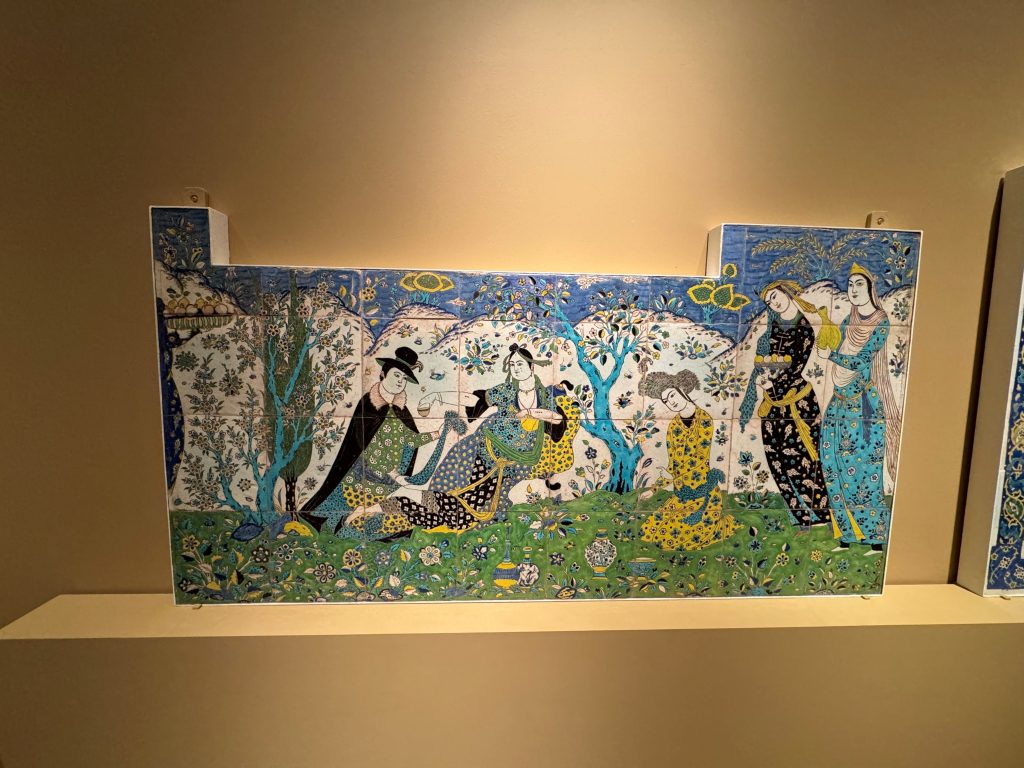
Iran, on the other hand, offers a diverse perspective on Islamic arts. Miniature books from the Shia tradition and works filled with symbolic elements are prominently displayed in the museum. Also noteworthy are the unique pieces from Morocco, where artisans spent years creating masterpieces, sometimes subtly inscribing the names of their newborn children into the artworks, adding a layer of uniqueness.
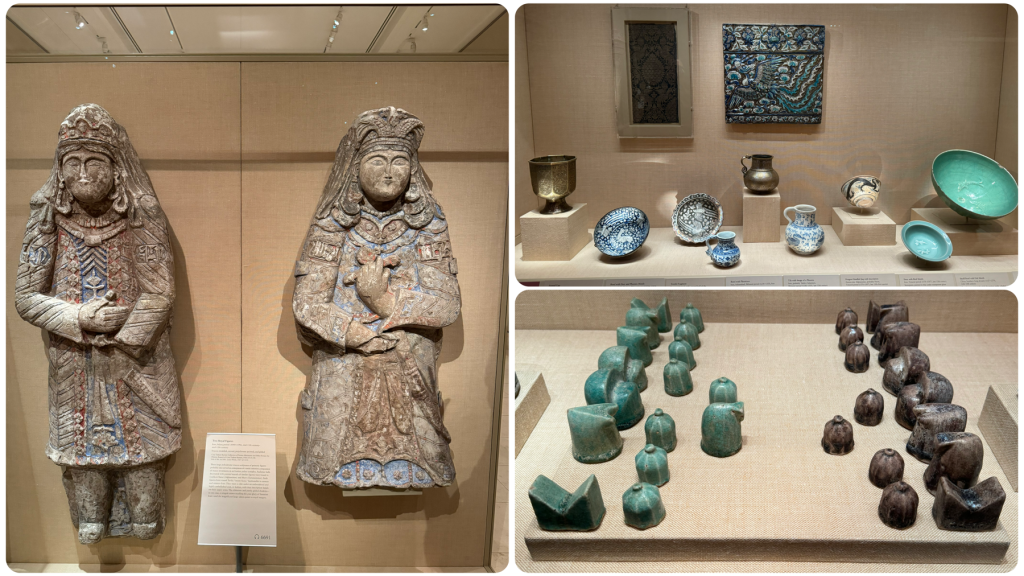
To sum up, the Islamic Art section at the Metropolitan Museum of Art beautifully encapsulates the artistic and cultural richness of various Islamic civilizations throughout history. Visiting this section made me appreciate how Islamic art evolved within its constraints and traditions, highlighting its significance in grasping the universal language of culture.
The Metropolitan Museum of Art has transformed its family galleries into a vital aspect of the museum, thanks to various sponsorships that support the acquisition and display of art. Major corporations and philanthropic families play a crucial role in preserving and showcasing these artworks through their donations. In return, the museum modestly allows for subtle branding by naming galleries after these sponsors, acknowledging their support in a very humble manner. I must say, these kinds of sponsorships play a crucial role in ensuring the sustainability of the museum. For instance, the Koç Family Gallery is one of the noteworthy sections of this museum. I was really impressed.
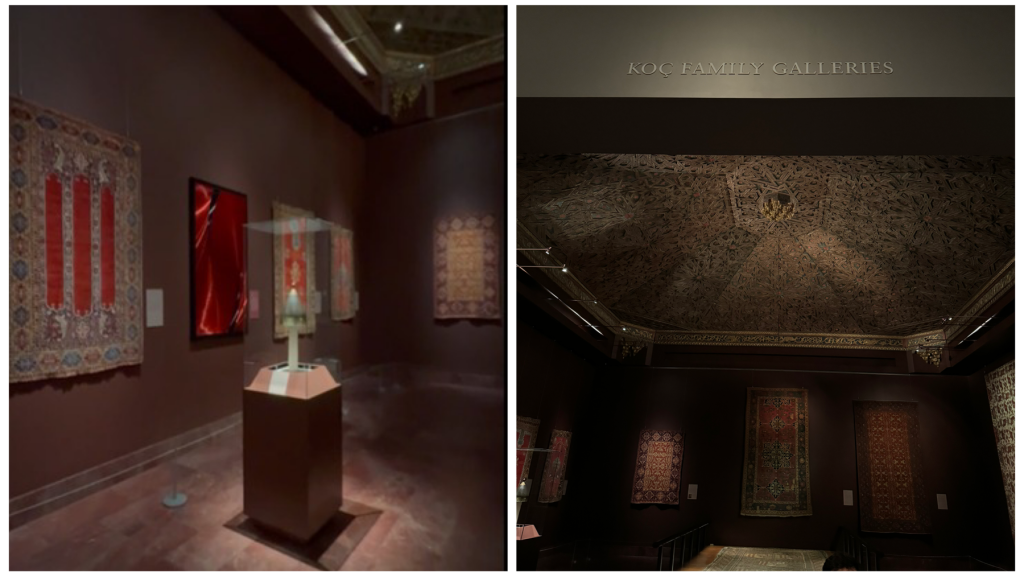
Here’s another fascinating, yet impressive point: the museum has successfully created a powerful connection by blending ancient and modern art. While the galleries share with you the traditional roots and historical background of the periods, suddenly, for instance, a piece by the late Burhan Doğançay (**), makes a striking appearance, clearly revealing the origin of today’s modern art.
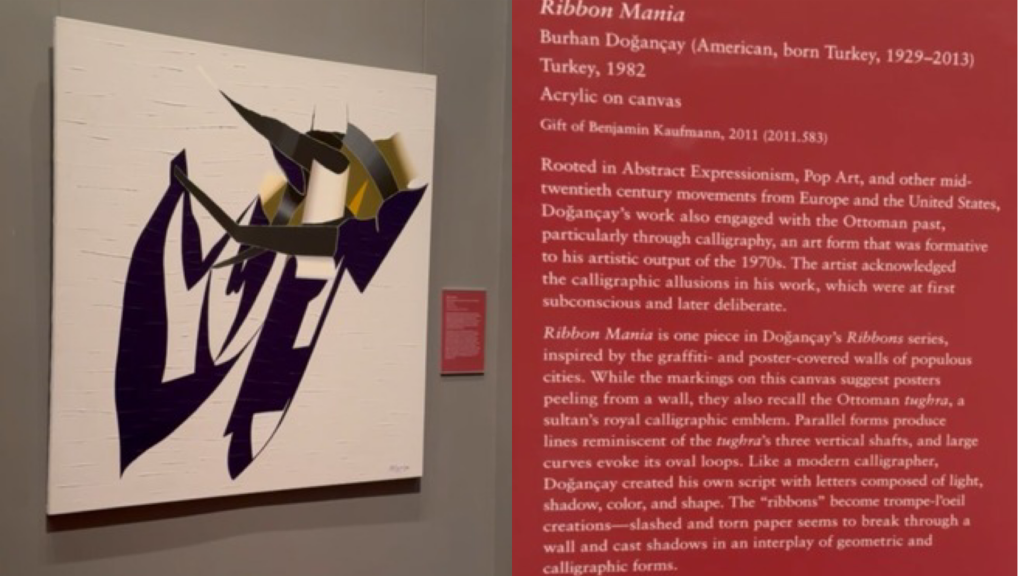
Just like with Turkish modern art, contemporary artists are actually using traditional motifs and techniques from their heritage to create new works. This is significant for understanding the evolution and continuity of art. The Met has done a great job of linking this, showing visitors how art has journeyed from past to present.

As I mentioned at the beginning, visiting this museum feels like traveling in a time machine. Large, three-dimensional installations of buildings, temples, and rooms from ancient times make you feel like you are truly experiencing those eras.
At this point, I have reached the end of my GOYA at the Metropolitan Museum of Art. For someone with a deep passion for art and history, it was truly a mesmerizing experience. The museum’s extensive collection, and its commitment to preserving cultural heritage and sharing it with the public, once again highlights the universal language of art. The blend of Islamic art with both modern and traditional works, coupled with the support of sponsors and the museum’s design, makes this an experience you simply can’t miss. The history and story behind each piece remind visitors of the inseparable nature of art and culture. Each moment you spend here will allow you to step into the fascinating world of art and history.
Footnotes:
(*) https://tr.wikipedia.org/wiki/New_York%27un_T%C3%BCm_Vermeerleri
(**) I cannot overlook mentioning Burhan Doğançay’s works displayed at the Metropolitan Museum of Art. Known for his influence on contemporary urban and street art, Doğançay was one of the most valuable Turkish artists of the 20th century. His award-winning works being part of the collection of a globally renowned museum today is, as you would agree, a well-deserved honor. Since this person was not only a remarkable artist but also a long-time friend of mine, finding his works at the Metropolitan Museum of Art added a deeply personal and emotional touch to my visit.
For art enthusiasts like you, we organized the “Burhan Doğançay Retrospective” exhibition, featuring the Blue Symphony among others, in collaboration with him at Yıldız Holding’s Çamlıca Campus. If you have a chance to visit Yıldız Holding in Istanbul, Çamlıca, or pladis in Chiswick, London, you can view these works by scheduling an appointment.
References:
https://en.wikipedia.org/wiki/Metropolitan_Museum_of_Art
https://www.metmuseum.org/about-the-met/history
Image: Metropolitan Museum of Art / Overview: https://www.metmuseum.org/
Note: This open-source article does not require copyright and can be quoted by citing the author.

